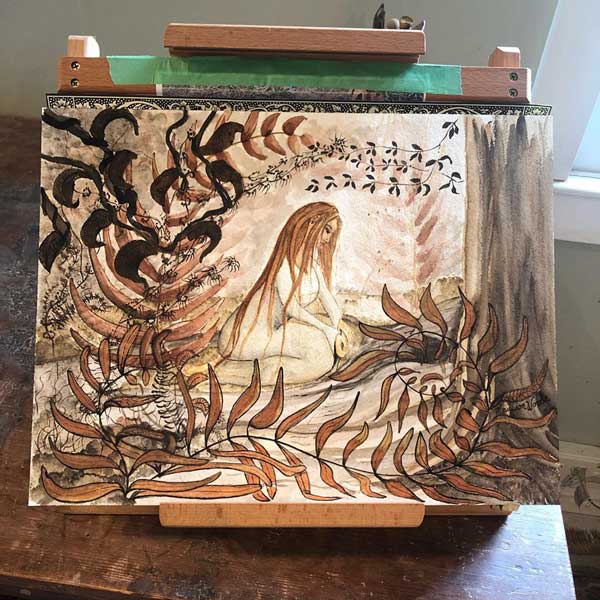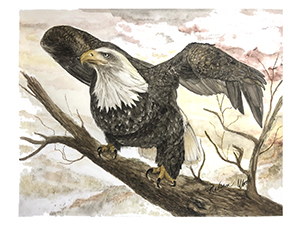
 45
45




![Filename: Kestrel-No-3-print-600px.jpg
Description: Kestrel no. 3 [Thumbnail for Kestrel-No-3-print-600px.jpg]](/t/93469/a/65877/Kestrel-No-3-print-600px.jpg)
Madison Woods
Rural Real Estate & Nature Art with Ozark Pigments
 2
2








Madison Woods
Rural Real Estate & Nature Art with Ozark Pigments
 19
19




 1
1




Madison Woods
Rural Real Estate & Nature Art with Ozark Pigments
 2
2




Cindy McKee wrote:Madison, I registered just to suggest that you try using the sap from wild cherry trees growing in the Ozarks instead of gum arabic. You can use the sap from any Prunus tree to make your binder. I get the balls that ooze from my peach tree to make watercolor binder and the paint is fine. If your binder is also sourced locally, your paint will be that much more authentically local.
Gardens in my mind never need water
Castles in the air never have a wet basement
Well made buildings are fractal -- equally intelligent design at every level of detail.
Bright sparks remind others that they too can dance
What I am looking for is looking for me too!

 1
1




Madison Woods
Rural Real Estate & Nature Art with Ozark Pigments
 6
6




Madison Woods
Rural Real Estate & Nature Art with Ozark Pigments
 4
4




 6
6




Madison Woods
Rural Real Estate & Nature Art with Ozark Pigments
 1
1




Tomorrow doesn’t exist and never will. There is only the eternal now. Do it now.
 9
9




Cindy Skillman wrote:Have you folks tried using honey as a binder? I’m not making my own paints (though I may since you have inspired me, when I have more time), but my favorite commercial brand uses honey as its binder. BTW, very impressed with your beautiful kestrel! Just lovely.
Madison Woods
Rural Real Estate & Nature Art with Ozark Pigments




 14
14




Madison Woods wrote:Francis - Awesome! Post some pics to show how it does.






 3
3




Madison Woods
Rural Real Estate & Nature Art with Ozark Pigments




 6
6
















 4
4




Tomorrow doesn’t exist and never will. There is only the eternal now. Do it now.
 6
6




Madison Woods
Rural Real Estate & Nature Art with Ozark Pigments











 9
9




Tomorrow doesn’t exist and never will. There is only the eternal now. Do it now.
 16
16




Madison Woods
Rural Real Estate & Nature Art with Ozark Pigments
 4
4




Cindy Skillman wrote:I just stumbled across a YouTube video where they’re using a tumbler/ball mill, and they *are* using water.
Madison Woods
Rural Real Estate & Nature Art with Ozark Pigments
 1
1




www.thedruidsgarden.com
 1
1




Dana Driscoll wrote:Madison, did you end up getting your mill?
Madison Woods
Rural Real Estate & Nature Art with Ozark Pigments
 7
7




 2
2




Madison Woods
Rural Real Estate & Nature Art with Ozark Pigments
 4
4




 2
2




Madison Woods
Rural Real Estate & Nature Art with Ozark Pigments
 1
1




 6
6




Marcelo Smith wrote: my experience with ball mills is a little more industrial
 1
1




Fred Norman wrote:Really nice artworks! Just saw your blog and I already found some interesting topics.
Madison Woods
Rural Real Estate & Nature Art with Ozark Pigments
 11
11





Madison Woods
Rural Real Estate & Nature Art with Ozark Pigments
 7
7











 9
9





Madison Woods
Rural Real Estate & Nature Art with Ozark Pigments
 12
12





Madison Woods
Rural Real Estate & Nature Art with Ozark Pigments




 9
9









 5
5




Madison Woods
Rural Real Estate & Nature Art with Ozark Pigments
 1
1




Madison Woods wrote:Hi, I make my watercolors from stones, clay, and a few of the light-fast plants I've found here in the Ozarks. Would love to share and discuss this topic with others who make or are interested in making paints. I'm going to be short on time to reply in depth or often until the end of November, but in the meantime I'll be able to drop by and contribute some between now and then.
I have some blog posts about making the paint and the media for watercolor here: (Updated with links to new website!)
https://www.paleopaints.com/make-your-own-watercolor/
https://www.paleopaints.com/media/
My favorite painting so far is attached to this post. This uses entirely Ozark colors. You can see some of the other paintings I've done with my colors here:
https://www.paleopaints.com/painting/
For the most part, I use only my local resources. But we don't have anything light-fast to make blue or green, so for those I use other stones or minerals or clay from other areas. For green I'm using French green clay and for blue I'm using lapis lazuli. I try to not use much blue at all because the stone is expensive and I only have a few rocks of it my husband brought me while he was working in Afghanistan.
Are any of you out there using your local sources to make paints? I know it's common with fiber artists to dye their own fibers. With painting, there are a lot of colors available, but not so many outside of the brown/yellow ranges that are light fast. The earth pigments (from stone or clay) are very light-fast, but I've only found sassafras and black gum so far as light fast plant sources. I suspect that maple and sweet gum might also be good sources, but haven't had time to test them yet.
 8
8




Morgan Lawson wrote:
wow! this looks amazing!
it looks like a picture in a book. I love it!
i definitely would like to see more works like this! please share with us :)
Madison Woods
Rural Real Estate & Nature Art with Ozark Pigments




 7
7








|
And then the flying monkeys attacked. My only defense was this tiny ad:
The new purple deck of permaculture playing cards
https://www.kickstarter.com/projects/paulwheaton/garden-cards
|





